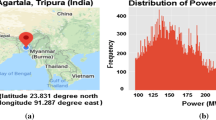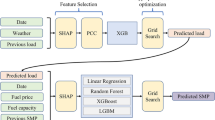Abstract
Electricity is an essential commodity that must be generated in response to demand. Hydroelectric power plants, fossil fuels, nuclear energy, and wind energy are just a few examples of energy sources that significantly impact production costs. Accurate load forecasting for a specific region would allow for more efficient management, planning, and scheduling of low-cost generation units and ensuring on-time energy delivery for full monetary benefit. Machine learning methods are becoming more effective on power grids as data availability increases. Ensemble learning models are hybrid algorithms that combine various machine learning methods and intelligently incorporate them into a single predictive model to reduce uncertainty and bias. In this study, several ensemble methods were implemented and tested for short-term electric load forecasting. The suggested method is trained using the influential meteorological variables obtained through correlation analysis and the past load. We used real-time load data from Nagaland’s load dispatch centre in India and meteorological parameters of the Nagaland region for data analysis. The synthetic minority over-sampling technique for regression (SMOTE-R) is also employed to avoid data imbalance issues. The experimental results show that the Bagging methods outperform other models with respect to mean squared error and mean absolute percentage error.












Similar content being viewed by others
References
Abida Choudhury B, Saha SK, Konwar M, Sujith K, Deshamukhya A (2019) Rapid drying of northeast India in the last three decades: climate change or natural variability. Journal of Geophysical Research: Atmospheres 124(1):227–237
Aier I, Sakhiya AK, Kaushal P, Vijay VK (2021) Scope of renewable energy intervention for energy sufficiency in Nagaland, Integrated Approaches Towards Solid Waste Management. Integrated Approaches Towards Solid Waste Management, pp 317–328
Amato U, Antoniadis A, Feis ID, Goude Y, Lagache A (2021) Forecasting high resolution electricity demand data with additive models including smooth and jagged components. Int J Forecast 37(1):171–185
Andriopoulos N, Magklaras A, Birbas A, Papalexopoulos A, Valouxis C, Daskalaki S, Birbas M, Housos E, Papaioannou GP (2021) Short term electric load forecasting based on data transformation and statistical machine learning. Appl Sci 11(1):158
Borah P, Singh MK, Mahapatra S (2015) Estimation of degree-days for different climatic zones of North-East India. Sustainable Cities and Society 14:70–81
Cecati C, Kolbusz J, Różycki P, Siano P, Wilamowski BM (2015) A novel rbf training algorithm for short-term electric load forecasting and comparative studies. IEEE Trans Ind Electron 62(10):6519–6529
Chawla NV, Bowyer KW, Hall LO, Philip Kegelmeyer W (2002) Smote: Synthetic minority over-sampling technique. J Artif Intell Res 16:321–357
Chen K, Chen K, Wang Q, He Z, Hu J, He J (2018) Short-term load forecasting with deep residual networks. IEEE Trans Smart Grid 10(4):3943–3952
Din GMU, Mauthe AU, Marnerides AK (2018) Appliance-level short-term load forecasting using deep neural networks. In: 2018 International conference on computing, networking and communications (ICNC), IEEE, pp 53–57
Fan S, Hyndman RJ (2011) Short-term load forecasting based on a semi-parametric additive model. IEEE Trans Power Syst 27(1):134–141
Fernández A, García S, Galar M, Prati RC, Krawczyk B, Herrera F (2018) Learning from imbalanced data sets. Springer
Genuer R, Poggi Jean-Michel, Tuleau-Malot C (2010) Variable selection using random forests. Pattern Recogn Lett 31(14):2225–2236
Georganos S, Grippa T, Vanhuysse S, Lennert M, Shimoni M, Wolff E (2018) Very high resolution object-based land use–land cover urban classification using extreme gradient boosting. IEEE Geosci Remote Sens Lett 15(4):607–611
Jhajharia D, Dinpashoh Y, Kahya E, Singh VP, Fakheri-Fard A (2012) Trends in reference evapotranspiration in the humid region of northeast India. Hydrol Process 26(3):421–435
Jhajharia D, Shrivastava SK, Sarkar DSAS, Sarkar S (2009) Temporal characteristics of pan evaporation trends under the humid conditions of northeast India. Agricultural and Forest Meteorology 149(5):763–770
Jhajharia D, Yadav BK, Maske S, Chattopadhyay S, Kar AK (2012) Identification of trends in rainfall, rainy days and 24 h maximum rainfall over subtropical Assam in Northeast India. Compt Rendus Geosci 344(1):1–13
Jhaveri S, Khedkar I, Kantharia Y, Jaswal S (2019) Success prediction using random forest, catboost, xgboost and adaboost for kickstarter campaigns. In: 2019 3Rd international conference on computing methodologies and communication (ICCMC), IEEE, pp 1170–1173
Ke G, Qi M, Finley T, Wang T, Chen W, Ma W, Ye Q, Liu Tie-Yan (2017) Lightgbm: A highly efficient gradient boosting decision tree. In: Advances in neural information processing systems, pp 3146–3154
Kumar S, Singh K, Kumar S, Kaiwartya O, Cao Y, Zhou H (2019) Delimitated anti jammer scheme for internet of vehicle: machine learning based security approach. IEEE Access 7:113311– 113323
Li S, Goel L, Wang P (2016) An ensemble approach for short-term load forecasting by extreme learning machine. Appl Energy 170:22–29
Li F, Jin G (2019) Research on power energy load forecasting method based on knn. International Journal of Ambient Energy, pp 1–6
Li F, Li Z, Chen B, Gao D, Cheng Y, Zhang X, Yang Y, Gao K, Huang Z, Peng J (2018) A light gradient boosting machine for remainning useful life estimation of aircraft engines. In: 2018 21St international conference on intelligent transportation systems (ITSC), IEEE, pp 3562–3567
Li W, Zhen-gang Z (2009) Based on time sequence of arima model in the application of short-term electricity load forecasting. In: 2009 International conference on research challenges in computer science, IEEE, pp 11–14
Miraftabzadeh SM, Foiadelli F, Longo M, Pasetti M (2019) A survey of machine learning applications for power system analytics. In: 2019 IEEE International conference on environment and electrical engineering and 2019 IEEE industrial and commercial power systems europe (EEEIC/i&CPS europe), IEEE, pp 1–5
Mishra G, Jangir A, Francaviglia R (2019) Modeling soil organic carbon dynamics under shifting cultivation and forests using Rothc model. Ecol Model 396:33–41
Moradzadeh A, Moayyed H, Zakeri S, Mohammadi-Ivatloo B, Pedro Aguiar A (2021) Deep learning-assisted short-term load forecasting for sustainable management of energy in microgrid. Inventions 6(1):15
Nepal B, Yamaha M, Yokoe A, Yamaji T (2020) Electricity load forecasting using clustering and arima model for energy management in buildings. Japan Architectural Review 3(1):62–76
Oliveira MO, Marzec DP, Bordin G, Bretas AS, Bernardon D (2011) Climate change effect on very short-term electric load forecasting. In: 2011 IEEE Trondheim powertech, IEEE, pp 1–7
Pal S, Dutta S, Nasrin T, Surajit C (2020) Hurst exponent approach through rescaled range analysis to study the time series of summer monsoon rainfall over northeast India. Theor Appl Climatol 142 (1):581–587
Park R-J, Song K-B, Kwon B-S (2020) Short-term load forecasting algorithm using a similar day selection method based on reinforcement learning. Energies 13(10):2640
Pedregosa F, Varoquaux G, Gramfort A, Michel V, Thirion B, Grisel O, Blondel M, Prettenhofer P, Weiss R, Dubourg V, Vanderplas J, Passos A, Cournapeau D, Brucher M, Perrot M, Duchesnay E (2011) Scikit-learn: machine learning in Python. J Mach Learn Res 12:2825–2830
Ray SN, Bose S, Chattopadhyay S (2021) A Markov chain approach to the predictability of surface temperature over the northeastern part of India. Theor Appl Climatol 143(1):861–868
Sadaei HJ, Enayatifar R, Abdullah AH, Gani A (2014) Short-term load forecasting using a hybrid model with a refined exponentially weighted fuzzy time series and an improved harmony search. International Journal of Electrical Power & Energy Systems 62:118–129
Singh AK, Bijimol G, Singh VB (1998) Performance of gladiolus in the low hills of Nagaland during Summer Indian J. Hill Farmg 11:51–54
Sudheer G, Suseelatha A (2015) Short term load forecasting using wavelet transform combined with holt–winters and weighted nearest neighbor models. International Journal of Electrical Power & Energy Systems 64:340–346
Talaat M, Farahat MA, Mansour N, Hatata AY (2020) Load forecasting based on grasshopper optimization and a multilayer feed-forward neural network using regressive approach. Energy 196:117087
Torgo L, Ribeiro RP, Pfahringer B, Branco P (2013) Smote for regression. In: Portuguese conference on artificial intelligence, Springer, pp 378–389
Trenberth KE (2011) Changes in precipitation with climate change. Clim Res 47(1-2):123–138
Velasco LCP, Polestico DLL, Abella DMM, Alegata GT, Luna GC (2018) Day-ahead load forecasting using support vector regression machines. Int J Adv Comput Appl (IJACSA) 9(3):22–27
Wan S, Yang H (2013) Comparison among methods of ensemble learning. 2013 International Symposium on Biometrics and Security Technologies, pp 286–290
Wood LA (1970) The use of dew-point temperature in humidity calculations. Journal of Research of the National Bureau of Standards–C. Engineering and Instrumentation C 74:117–122
Yang Y, Che J, Deng C, Li L i (2019) Sequential grid approach based support vector regression for short-term electric load forecasting. Appl Energy 238:1010–1021
Yang X, Cheng G, Liu H (2015) Improved empirical mode decomposition algorithm of processing complex signal for iot application. International Journal of Distributed Sensor Networks 11(10):862807
Yi D, Dong Z, Zhao T, Li Z, Ding Z (2021) Short term load forecasting with markovian switching distributed deep belief networks. International Journal of Electrical Power & Energy Systems 130:106942
Yi L, Niu D, Hong W-C (2019) Short term load forecasting based on feature extraction and improved general regression neural network model. Energy 166:653–663
Yuk YY (1998) Climate and residential electricity consumption in Hong Kong. Energy 23(1):17–20
Zhang D, Qian L, Mao B, Huang C, Huang B, Si Y (2018) A data-driven design for fault detection of wind turbines using random forests and xgboost. IEEE Access 6:21020–21031
Zhao H, Yu H, Li D, Mao T, Zhu H (2019) Vehicle accident risk prediction based on adaboost-so in vanets. IEEE Access 7:14549–14557
Author information
Authors and Affiliations
Corresponding author
Ethics declarations
Conflict of interest
The authors declare no competing interests.
Additional information
Author contribution
All the authors participated and contributed equally in the analysis and interpretation of the results and data, drafting the article or revising it critically and preparing the final version.
Availability of data and material
The data sets used and/or analyzed during the current study are available from the corresponding author on reasonable request.
Code availability
The custom code used in the current study is available from the corresponding author on reasonable request.
Publisher’s note
Springer Nature remains neutral with regard to jurisdictional claims in published maps and institutional affiliations.
Rights and permissions
About this article
Cite this article
Sarkar, D., Ao, T. & Gunturi, S.K. Bootstrap aggregating approach to short-term load forecasting using meteorological parameters for demand side management in the North-Eastern Region of India. Theor Appl Climatol 148, 1111–1125 (2022). https://doi.org/10.1007/s00704-022-03933-9
Received:
Accepted:
Published:
Issue Date:
DOI: https://doi.org/10.1007/s00704-022-03933-9




